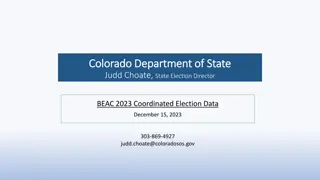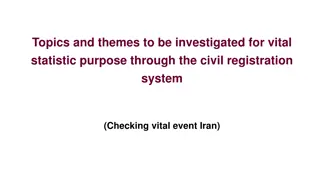Modernizing Civil Registration System: Ethiopia's Recent Progress
Ethiopia has made significant strides in modernizing its civil registration system in recent years. With a focus on birth, death, marriage, and divorce events, the government has implemented a robust legal framework and established a national agency to oversee the registration process. This initiative marks a crucial step towards ensuring accurate vital statistics and identity management for the country's large and diverse population.
Download Presentation

Please find below an Image/Link to download the presentation.
The content on the website is provided AS IS for your information and personal use only. It may not be sold, licensed, or shared on other websites without obtaining consent from the author. Download presentation by click this link. If you encounter any issues during the download, it is possible that the publisher has removed the file from their server.
E N D
Presentation Transcript
Presentation to Technical Seminar on Legal Frame Work for Civil registration , Vital Statistics and Identity Management . July 2017, Manila, Philippines
Background Ethiopia: Location: Horn of Africa having common boundary with Eretria, Sudan, S. Sudan, Kenya, Somalia and Djibouti. Area: 1.1 million Sq. Km having different topography. A country of diverse culture and ethnic groups. Population: 100 million, this makes the country to be the second most populous next to Nigeria in Sub Saharan Africa. Growth rate: 2.6 % per annum. The most dominant segment is the young population. Rural population accounts for 84%, while Urban accounts for 16%. System of Government: Federal (Decentralized) System - Nine regional states and Two city administrations. The regional states and city administrations are sub divided into more than 103 administrative zones, 993 weredas (Districts) and 18509 kebeles (local administration level)
Background The historical attempt to establish vital events registration system in Ethiopia started during the reign of Minilik II. After time the other effort to establish the conventional vital events registration system in Ethiopia was mainly associated with the inclusion of the civil registration provisions (about 100 Articles) in Civil code of 1960. However, Article 3361 (1)of the code states that registration of civil status shall not come into force until a day to be notified by Order published and the Order was not published and the provisions of the code was not enforced. Until now, the sources of vital events information have been the population census and house hold surveys conducted by CSA and municipalities registration and issuing of certificates (Addis Ababa, Gondor, Hawasa, Diredawa, etc.)
Recent Efforts Made by Government Only Five years ago that the Ethiopia government took appropriate measures to establish the modern Civil registration system in the Country. These measures are: 1) Legal Framework: (The registration of vital events and National Identity Card /The proclamation No 760/2012 and The Regulation on the Establishment of the Vital Events Registration Agency VERA (No 278/2012) urge all the concerned bodies to undertake the universal, complete, continuous and permanent civil registration mainly focusing on birth, death, marriage and divorce in the country. Of course, adoption, recognition and legitimation are other events included in Proclamation.
Recent.. According to the proclamation the federal agency is vested with the responsibilities of : directing, coordinating supporting the vital events registration system all over the country and organizing central archive while the regions agencies also do the same thing in their respective areas.
Recent.. But now the proclamation provisions have been amended regarding: The scope of civil registration to include Non- Ethiopians and refugees residing in Ethiopia, Provision of notification paper by the health facilities, declarants and their finger prints , the place registration, the period of transferring the copies or records (30 days to 45 days). Registration of backlogs using evidentiary documents. Specifying the authority to ratify the payment regulation. The draft of amendment has been adopted by the ministry of council and the parliament.
2. Organizational Structure Federal and Regional Registration Bodies .CSA Federal Vital Events Registration Council Regional Vital Events Registration Council Other Registering Bodies Ethiopian Embassies and Conciliates, Ministry of Defense Ethiopian Ships ARRA(Admin. For Refugees and Returns Affairs) Board of Management Board of Management Director General of Regional Vital Events registration Director General of Federal Vital Events Agency Zonal Registration Office 2 Zonal Registration Office 1 Woreda 1 Kebele 1 Kebele 2 Woreda 2 Kebele 1 Woreda 1 Woreda 2 Kebele 1 Kebel1e 1 1 Kebele 2 Kebele 2 Kebele 2
Efforts made by FVERA and RVERA 1) Awareness creation programmes at federal and reginal levels. 2. Capacity Building programmes at Federal and reginal level ( TOT and face to face trainings) . 3) Preparation and distribution of registering tools (registers, certificates) and directives. (The federal agency has prepared and made distribution arrangement of registers, certificates and directives) 4. Developing strategy document 2008-2012 E.C (2015/6- 2019/20) 5. Signing MOU with MOH. 5. Launching of Registration across the country in July 2016.
Registering Bodies and Registration Coverage During the launching time of 18506 kebels only 10122 (55%) kebels were ready to begin registration. But now of 18506 kebels 14253(74.5%) are carrying out the registration Process all over the country. The last 9 months report shows that 426997 vital evets have been registered. For instance: Birth 283,747 Marriage .77065 Divorce .5769 Death ..63239 Adoption .134 Total ..429,954
Flow of Information (Copies) CSA FVERA (Central Archiving) Authority for Refugees and Returns Ethiopian Shipping lines Ministry of Defense RVERA Ministry of Foreign Affairs ZONE Ethiopian Mission Camp Woreda Normal transfer If there is correction Kebele
opportunities Administration structure (up to local level) Political commitment (enacting laws, budgeting) Cultural assets (Practices) Coordination (with stakeholders and donors: UNICEF, World Bank.
Challenges Lack of Awareness of the importance of civil registration. Absence of convenient registration offices and office furniture ( table, chair, shelf, etc) at local level. Absence and turn over of kebele managers at local level. The law capacity of printing Press (Berhanina Selam) and not printing on fixed time. (Now almost all kebels have got the registering tools). Poor infrastructure at local level. Lack of archiving places and shelves. Lack of vehicles to monitor and support the registration processes at wereda and kebele levels.























